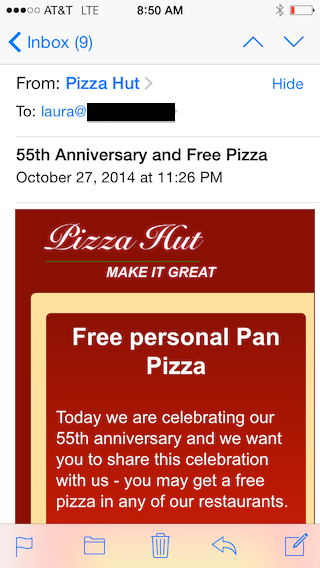Ransomware email protected by DMARC
Virus bulletin has an interesting post about DMARC and how some criminals are protecting their emails with DMARC.
Virus bulletin has an interesting post about DMARC and how some criminals are protecting their emails with DMARC.
There’s been a heavy uptick in botnet spam over the last few days, judging by things I’m hearing and my own mailboxes. There are a few common subject lines, but all of them are trying to get recipients to either run programs or visit malicious web pages.
The first subject line I’m seeing a lot of is “<name> wants to be friends with you on facebook!” In my mailbox most of those names have not been common European names. The give away that this isn’t actually a Facebook invite is the Reply-To address pointing to Linkedin. The URLs in the message appear to be random strings of numbers, and may actually encode recipient information in them.
The second has a subject that that is a variation on “End of July Statement.” The spammers are mixing capitals, adding in “Re:” and “FWD:” and sometimes increasing the urgency by adding required or STAT!! to the mail. These mails contain a .zip file which probably contains some virus which will turn the recipient machine into the next spam spewing bot.
The third variation has the subject line “Uniform Traffic Ticket.” The content is a citation that tells the recipient they were speeding somewhere in New York (possibly other states, I have only done a spot check of the couple hundred copies I have). There is, however, a .zip attachment with a virus.
Most people probably aren’t seeing these. SpamAssassin is doing a reasonably good job here of catching the spam and filtering it. I’m sure that the bigger ISPs are also filtering it effectively. But one person did forward a copy of the spam to a mailing list and ask if anyone knew what was going on.
If you get any of these messages, you don’t need to ask. It’s virus spam. Don’t open it and don’t forward it.
Some mornings I check mail from my phone. This showed up this morning.
My first thought was “oh, no, Pizza Hut is spamming, wonder who sold them my address.”
Then I remembered that iOS is horrible and won’t show you anything other than the Friendly From and maybe it was some weird phishing scheme.
When I got to my real mail client I checked headers, and sure enough, it wasn’t really from Pizza Hut. I’m guessing actually malware, but I don’t have a forensics machine to click the link and I’m not doing it on anything I can’t wipe (and have isolated from the rest of my network).
The frustrating thing for me is that this is an authenticated email. It not from Pizza Hut, the address belongs to some company in France. Apparently, that company has had their systems cracked and malware sent through them. Fully authenticated malware, pretending to be Pizza Hut, and passing authentication on various devices.
Pizza Hut isn’t currently publishing a DMARC record, but in this case, a DMARC record for Pizza Hut wouldn’t matter. None of the email addresses in the headers point to Pizza Hut.
I spent last week listening to a lot of people discussing DMARC and authentication and protecting people from scams and headers. But those all the protocols in the world won’t protect against this kind of thing. Phishing and malware can’t be fixed by technology alone. Even if every domain on the planet published a p=reject policy, mail like this would still get through.
According to a recent blog post, Office365 is starting to evaluate incoming messages for DMARC. I talked a little bit about DMARC in April when Yahoo started publishing a p=reject message.
Read More